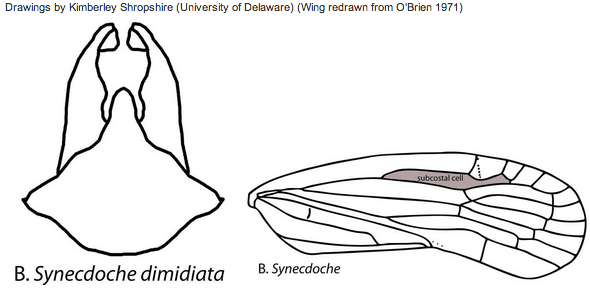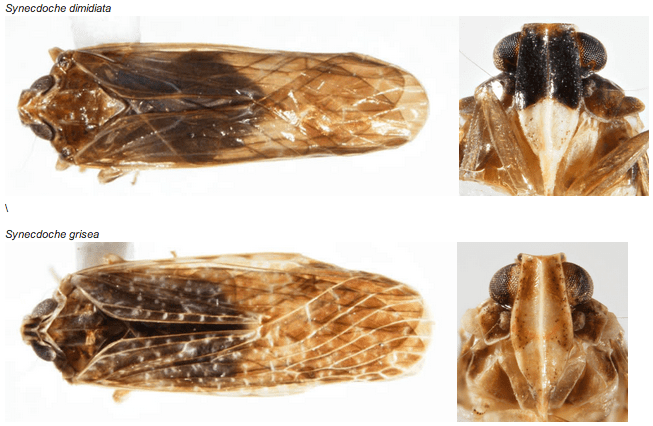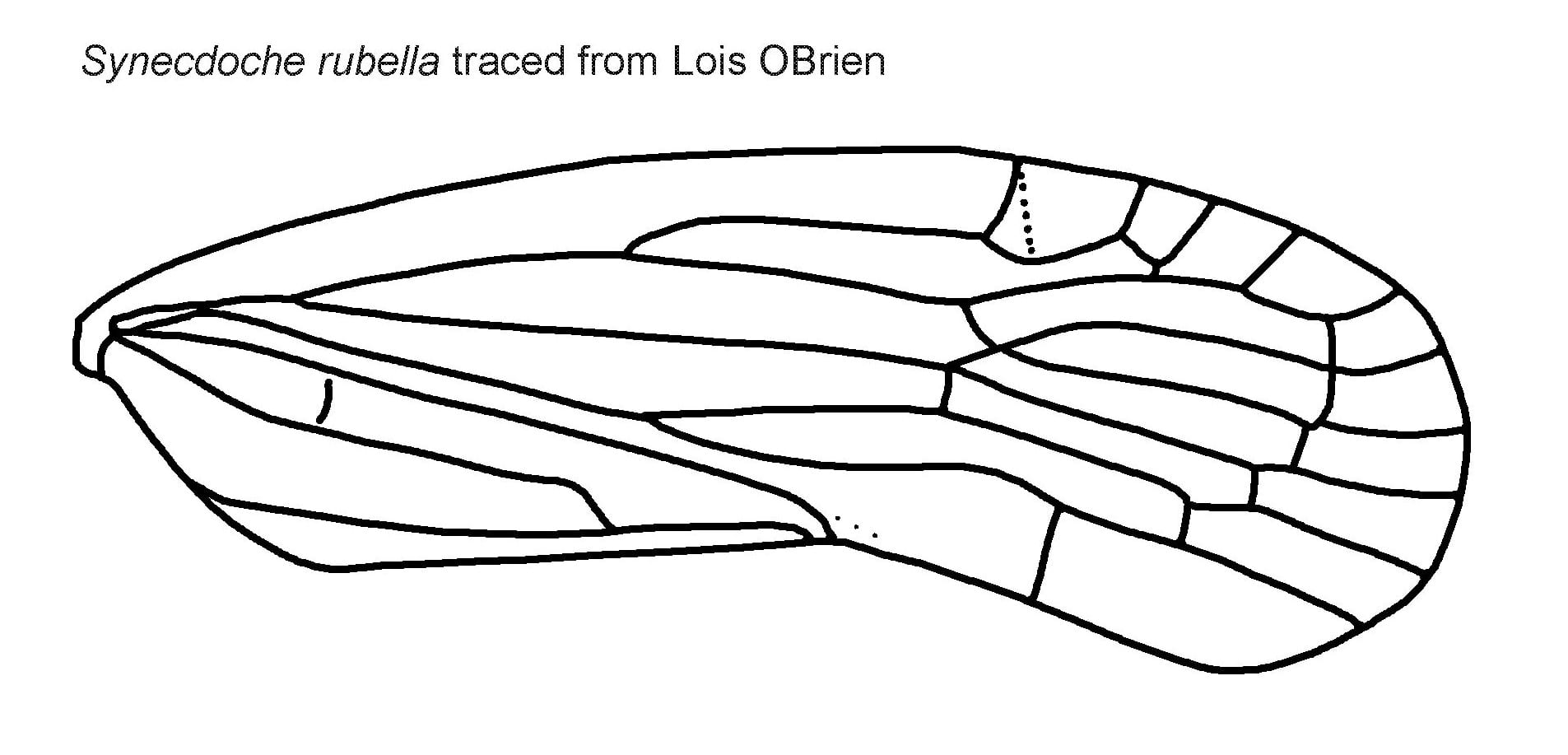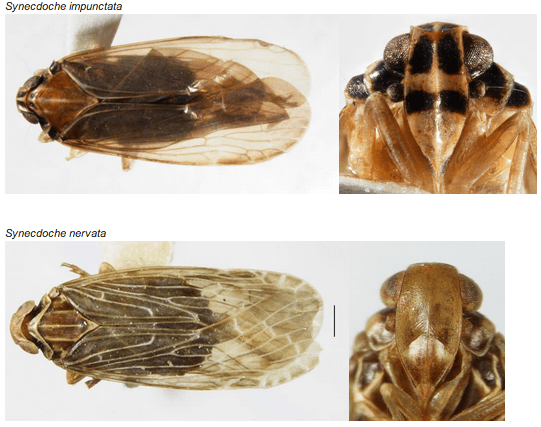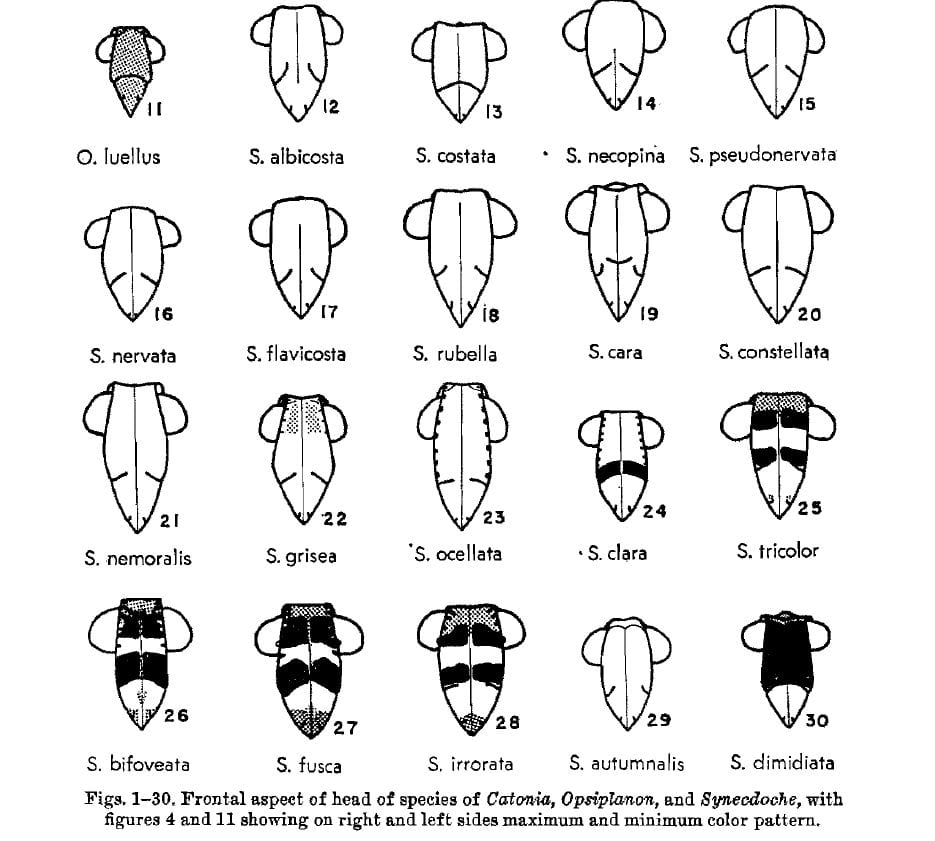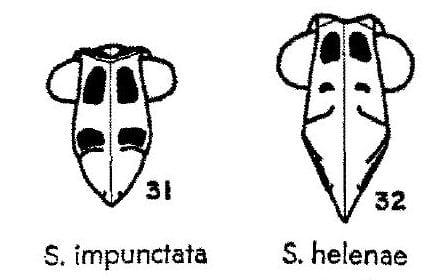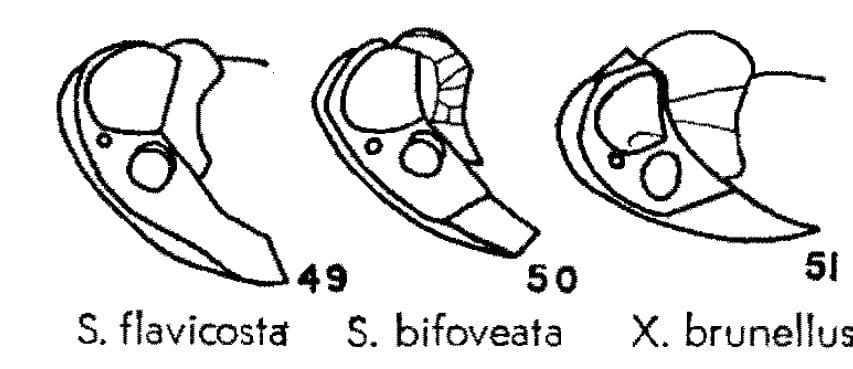[Return to North American Achilidae]
Contents
Family Achilidae Stål, 1866
Subfamily Achilinae Stål, 1866
Tribe Plectoderini Fennah, 1950
Genus: Synecdoche O’Brien, 1971
Type species: Catonia grisea Van Duzee, 1908.
Synonyms: None.
Distribution:
Widespread in the New World (especially west), most described species Nearctic, but Neotropical taxa inadequately characterized. One species improbably described from Viet Nam.
Recognized species
There are 22 species (or so) in this genus:
1 Synecdoche albicosta (Van Duzee, 1917) – USA: CA
2 Synecdoche autumnalis O’Brien, 1971 – USA: CA
3 Synecdoche bifoveata O’Brien, 1971 – USA: CA
4 Synecdoche cara (Van Duzee, 1910) – USA: CA
5 Synecdoche clara (Van Duzee, 1917) – USA: CA
6 Synecdoche constellata (Ball, 1933) – USA: CA, WA; CAN: BC
7 Synecdoche costata (Van Duzee, 1910) – USA: CA; Mexico (Baja California)
8 Synecdoche dimidiata (Van Duzee, 1910) – USA: CT, FL, GA, MD, ME, NC, NH, NJ, NY, OH, PA, RI, VA, WV; CAN: ON, NS, QC
9 Synecdoche flavicosta O’Brien, 1971 – USA: CA
10 Synecdoche fusca (Van Duzee, 1908) – USA: CA
11 Synecdoche grisea (Van Duzee, 1908) – USA: CT, IA, IL, IN, KY, LA, MD, MI, NC, NY, OH, PA, TN, VA; CAN: ON, QC
12 Synecdoche helenae (Van Duzee, 1918) – USA: CA
13 Synecdoche hypenor Fennah, 1978 – Viet Nam
14 Synecdoche impunctata (Fitch, 1851: 46) – USA: CT, DC, DE, GA, IA, IL, IN, MA, MD, ME, MI, MS, NC, NH, NJ, NY, OH, OK, PA, RI, TN, VA, WV; CAN: ON, QC
15 Synecdoche irrorata (Van Duzee, 1914) – USA: CA; Mexico (Baja California)
16 Synecdoche necopina (Van Duzee, 1918) – USA: CA; Mexico (Baja California)
17 Synecdoche nemoralis (Van Duzee, 1916) – USA: AZ, CA, CO, NV, OR, UT, WA; CAN: BC
18 Synecdoche nervata (Van Duzee, 1910) – USA: CA
19 Synecdoche ocellata O’Brien, 1971 – USA: CA
20 Synecdoche pseudonervata O’Brien, 1971 – USA: CA; Mexico (Baja California)
21 Synecdoche rubella (Van Duzee, 1910) – USA: CA, OR
22 Synecdoche tricolor O’Brien, 1971 – USA: AZ
Economic Importance:
Limited.
Known host plants:
Nymphs of achilids associated with fungus (usually in logs). The significance of adult host association is unclear.
[list to come – many noted]
Hosts from O’Brien 1971, Wilson et al. 1994; plant names from USDA PLANTS.
Recognition:
Similar to Catonia (sometimes a little larger); Subcostal cell of forewing longer than 1/3 length of wing, narrow throughout; medioventral lobe of male pygofer simple, beak shorter than Xerbus, frons not marked like Momar.
KEY TO THE SPECIES OF SYNECDOCHE IN NORTH AMERICA (modified from O’Brien 1971)
l , Frons pale, concolorous, at most mottled (figs. 12-23, 29) … 2
1.- Frons with large dark brown spots or bands, or all dark (figs. 24-28, 30-32) … 14
- Tegmina with many pale raised transverse incomplete cross veins (grisea species group) … 11
2.- Tegmina without, or with 7 or less, incomplete cross veins (albicosta species group, except autumnalis … 3
- Vertex at least twice as broad as long … 4
3.- Vertex less than 1-3/4 times as broad as long… 9
- Costal cell and sometimes cross veins white, rest of tegmina concolorous … 5
4.- Tegmina. patterned, not concolorous except for costal cell… 7
- Cross veins of tegmina white, frontoclypeal suture transverse (figs. 13-14), insect usuallymedium to dark brown … 6
5.- Cross veins concolorous with wing, frontoclypeal suture angled upward (fig. 12), straw colored to medium brown … albicosta (Van Duzee)
- Frons carinate, frons and base of clypeus pale … costata. (Van Duzee)
6.- Frons not carinate, clypeus and apex of frons dark, paler towards base of frons … necopina (Van Duzee)
- Tegmina with a pale transverse diamond-shaped area reaching medially from mesonotum to lip of clavus … cara (Van Duzee)
7.- Tegmina. brown with pale veins, sometimes center of cells pale … 8
- Vertex 2-1/2 times as wide as long, with basal and apical margins subparallel … nervata (Van Duzee)
8.- Vertex twice as wide as long, apical margin produced, not subparallel to basal margin … pseudonervata O’Brien
- Lateral compartments of frons concave from apex to raised area at base, lateral carinae
above level of disc … autumnalis O’Brien
9.- Lateral compartments of frons concave only at apex, not above level of ocelli, lateral
carinae above ocelli at same level as disc … 10
- Frontoclypeal suture incomplete, tegmina or at least veins usually reddish … rubella (Van Duzee)
10.- Frontoclypeal suture complete, tegmina and veins pale yellowish brown … flavicosta O’Brien
- In lateral view, apex of head smoothly rounded (as fig. 49) … constellata (Ball)
11.- In lateral view, apex of head pointed, not smoothly rounded (as fig. 50) … 12
- Lateral areolets carinate anteriorly, vertex with four long dark stripes, mesonotum with pair of more or less distinct ocellate spots; female with apical margin of pregenital sternite entire … 13
12.- Lateral areolets not carinate apically, merely raised; vertex usually concolorous mesonotum not so patterned; female with small median projection on pregenital sternite … nemoralis (Van Duzee)
- Eastern species (east of 100th meridian), frons sometimes mottled at base (fig. 22) … grisea (Van Duzee)
13.- Western species, frons clear (fig. 23) … ocellata O’Brien
- 14. Tegmina with many pale raised transverse incomplete veinlets (fusca species group) … 15
14.- Tegmina. without transverse veinlets (impunctata species group) … 19
- Frons with dark band at clypeus, at most mottled above (fig. 24) … clara (Van Duzee)
15.- Frons with two dark bands, or if only one, then specimen from Arizona (see tricolor) (figs. 25-28) … 16
- 16. Basal area of frons without dark spots along lateral carinae (fig. 25) … tricolor O’Brien
16.- Basal area of frons with dark spots along lateral carinae (figs. 26-28) … 17
- Edge of apical dark band not coinciding with frontoclypeal suture, pale triangular area laterally … irrorata (Van Duzee)
17.- Edge of apical dark band coinciding with frontoclypeal suture … 18
- Vertex twice as wide as long … bifoveata O’Brien
18.- Vertex 1.6 times as wide as long … fusca (Van Duzee)
- Frons entirely dark, contrasting sharply with clypeus … dimidiata (Van Duzee)
19.- Frons pale with dark spots (figs. 31-32) … 20
- Apical dark spots on frons almost touching frontoclypeal suture (fig. 31) … impunctata (Fitch)
20.- Pale area along frontoclypeal suture, dark spots basad ( fig. 32) … helenae (Van Duzee)
Online resources
Collecting
Most often taken at lights.
Molecular resources:
At this time GenBank does not appear to have data for Synecdoche, and Barcode of Life has data for 2 Synecdoche species (Synecdoche dimidiata, S. impunctata)
Selected references:
Ball, E. D. 1933. Some new Western leafhoppers of the fulgorid family Achilidae. Pan-Pacific Entomologist 9: 133-138.
Bartlett, C.R., L.B. O’Brien and S.W. Wilson. 2014. A review of the planthoppers (Hemiptera: Fulgoroidea) of the United States. Memoirs of the American Entomological Society 50: 1-287.
Caldwell, J. S. and L. F. Martorell. 1951 [dated 1950]. Review of the Auchenorynchous [sic] Homoptera of Puerto Rico. Part II. The Fulgoroidea except Kinnaridae. Journal of Agriculture of the University of Puerto Rico 34(2): 133-269.
Emeljanov, A. F. 1992. Toward the problem and limits and subdivisions of Achilidae (Homoptera, Cicadina). Entomological Review 71(1): 53-73 (Translation of Entomologicheskoye Obozreniye 1991, 70: 373-393, in Russian).
Emeljanov, A. F. 1993. Description of tribes of the subfamily Achilinae (Homoptera, Achilidae) and revision of their composition. Entomological Review 72(6): 7-27 (Translation of Entomologicheskoe Obozrenie 71: 574-594 from Russian).
Fennah, R. G. 1945. New Lanternflies (Fulgoroidea) From South America. Proceedings of the United States National Museum 96(3189): 95-106.
Fennah, R. G. 1950. A generic revision of the Achilidae (Homoptera: Fulgoroidea) with descriptions of new species. Bulletin of the British Museum (Natural History) Entomology 1: 1-170.
Fennah, R. G. 1978. Fulgoroidea (Homoptera) from Vietnam. Annales Zoologici 34(9): 207-279.
Fitch, A. 1851. Catalogue with references and descriptions of the insects collected and arranged for the State Cabinet of Natural History. Annual Report of the Regents of the University on the Condition of the State Cabinet of Natural History, and the Historical and Antiquarian Collection 4: 43-69.
Metcalf, Z. P. 1948. General catalogue of the Hemiptera. Fasc. IV. Fulgoroidea, Part 10. Achilidae. Smith College, Northampton, Massachusetts. 85 pp.
O’Brien, L. B. 1971. The systematics of the tribe Plectoderini in America north of Mexico (Homoptera: Fulgoroidea: Achilidae). University Of California Publications in Entomology 64: 1-79.
O’Brien, L. B. 1985. New synonymies and combinations in New World Fulgoroidea (Achilidae, Delphacidae, Flatidae, Fulgoridae: Homoptera). Annals of the Entomological Society of America 78(5): 657-662.
Spinola, M. 1839. Essai sur les Fulgorelles, sous-tribu de la tribu des Cicadaires, ordre des Rhyngotes. Annales de la Société Entomologique de France 8: 133-337.
Stål, C. 1866a. Hemiptera Homoptera Latr. Hemiptera Africana vol. 1-2. Officina Norstedtiana, Stockholm, Sweden. 256 + 181 pp. [From Smithsonian Biodiversity Heritage Library http://www.biodiversitylibrary.org/] (partial translation)
Van Duzee, E. P. 1908. Studies in North American Fulgoridae. Proceedings of the Academy of Natural Sciences of Philadelphia 1907: 467-498.
Van Duzee, E. P. 1910. Notes on genus Catonia (Homoptera). Canadian Entomologist 42: 261-265.
Van Duzee, E. P. 1914. A preliminary list of the Hemiptera of San Diego Country, California. Transactions of the San Diego Society of Natural History. 2: 1-57.
Van Duzee, E. P. 1916. Notes on some Hemiptera taken near Lake Tahoe, California. Technical Bulletin. University of California, College of Agriculture, Agricultural Experiment Station. Entomology 1: 229-249.
Van Duzee, E. P. 1917. Report upon a collection of Hemiptera made by Walter M. Giffard in 1916 and 1917, chiefly in California. Proceedings of the California Academy of Sciences (4) 7: 249-318.
Van Duzee, E. P. 1918. New species of Hemiptera chiefly from California. Proceedings of the California Academy of Sciences. (4) 8: 271-308.
Wilson, S. W., C. Mitter, R. F. Denno and M. R. Wilson. 1994. Evolutionary patterns of host plant use by delphacid planthoppers and their relatives. In: R.F. Denno and T.J. Perfect, (eds.). Planthoppers: Their Ecology and Management. Chapman and Hall, New York. Pp. 7-45 & Appendix


